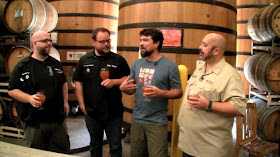San Diego Beer Week was amazing. I don't know where to start so I picked my favorite event. Plus this is educational

.
On Thursday Nov. 11 at Blind Lady Ale House (or BLAH) they had a special flight of New Belgium beers (mostly sours). And for a select group we were guided through the beers by Eric Salazar (think Eric's Ale) who is a big player in the New Belgium sour beers. Eric has been working at NB for around 15 years. He is heavily involved in the Lips of Faith series. He had the chance to brew Eric's ale by winning a contest where 3 beers are blended and whoever can guess the beers and proportions gets to brew their beer (The Lips of Faith series started as a way to get all employees involved with brewing and that beer was served at the brewery, now it refers to their unique beers). On to the beers.
The Flight and my notes:
 Trans-Atlantic Kriek
Trans-Atlantic Kriek -
Boon's Oude Kriek (6.5%) that is 50/50 blended with their Strong Golden Lager (they seem to use this base beer often. By my calcs it is 9.5%. I think it is used to really build body in their beers). Eric explained that Frank Boon sends them an "oil tanker" of the beer. And they were instructed to feed the Golden Lager into the Kriek (Eric and I both can't figure out the reason)
 Biere de Mars
Biere de Mars - I didn't get a lot about this beer but also wasn't to impressed. It only had a mild Brett character which is Brett L (according to Eric) and its added at bottling. After the fact I'm not sure how this works. How do they know how if they will have bottle bombs? And an issue we talked about later is that they don't want bugs to contaminat the bottling line.
 Sahti
Sahti - Interesting beer that I will have to try at home. They used juniper boughs in the mash tun which seems like a lot of fun. And it had a nice "gin" finish that I actually liked.
 Belgo IPA
Belgo IPA - Not much to talk about here. They used 1 of their 2 house Belgian strands (the more clove forward strain) but that was hard to find under all the hops.
 Eric's Ale
Eric's Ale - This beer starts as a Strong Golden Ale and then peach juice is added. In order to make sure that this beer is not too sweet a lager yeast is pitched. Once this ferments out then it is blended with Felix (more info below). My follow-up questions will include what type of peach and how much.
 La Folie
La Folie - The American Rodenbach. This beer is just a blend of Oscar (see below).
I tried to figure out how they approach sour brewing at NB. So from what I understand from my conversation with Eric. They started with the traditional bugs (lacto, pedio, brett) and pitched them into a bunch(lots) of barrels. And over the course of several years they got rid of the bad barrels and repitched more of the bugs from the good barrels (not sure how they control their ratios, like lacto getting out of control, more Qs). Eventually they moved up to using French Oak foudres. They now have 20 with 10 filled with Felix and 10 with Oscar. Oscar is their dark sour base (La Folie) and Felix is their pale base (Eric's Ale, Tart Lechee). Each of these foudres taste a bit different based on their location in the brewery. (This made me want to try the same wort and bugs but in different locations in my house). Supposedly foudre #3 is tasting really good right now. And once and a while you will here about a LOVE barrel. This is a single barrel or foudre that tastes great on its own. It can be Oscar or Felix. Some of the beers after they are blended are left to age in the barrel.
Mike, the
Mad Fermentalist, wanted me to ask about how they package the beer now compared to pre Lips of Faith. So I asked Eric and he explained the main change has been do to the volume change. Since moving to a Lips of Faith series they now produce 300 hectoliters instead of 30 hectoliters. And this means that the beer needs to be bottled on their main bottling line. And that means it must be pasturized so as to not contaminate the rest of their beers. Before it was all hand corked! And this allowed the beer to be in a different part of the brewery and these bottles could take the added pressure over time. Good News. Eric said they should have a corking line soon.

Eric also mentioned to look out for their Collaboration with Allagash on a beer called
Vrienden. For a good article and video.
check it.
Eric was a very nice, down to earth guy that amused my questions. He actually turned a few questions back on me. And was very interested in what people are doing with homebrewing sours. I plan to follow up by sending him a few beers and a few questions I didn't think about at the time.
And Thanks Dan and Meagan for drinking with me and putting up with my nerding out.



































